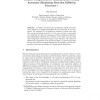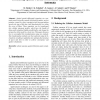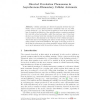47 search results - page 6 / 10 » Changing the Neighborhood of Cellular Automata |
RAS
2006
13 years 7 months ago
2006
Self-reconfigurable robots are built from modules, which are autonomously able to change the way they are connected. Such a robot can, through this self-reconfiguration process, c...
ACRI
2010
Springer
13 years 9 months ago
2010
Springer
A method of constructing asynchronous cellular automata (ACA model) as a parallel composition of two interacting ACA is presented. The resulting ACA is intended to simulate a proce...
BIOCOMP
2009
13 years 5 months ago
2009
Abstract-- Spatial partial differential equations are commonly used to describe systems of biological entities, such as patterns created by desert vegetation and biovermiculation g...
ACRI
2006
Springer
14 years 1 months ago
2006
Springer
Cellular automata are discrete dynamical systems that are widely used to model natural systems. Classically they are run with perfect synchrony ; i.e., the local rule is applied to...
CORR
2010
Springer
13 years 7 months ago
2010
Springer
This paper provides a bridge between the classical tiling theory and cellular automata on one side, and the complex neighborhood self-assembling situations that exist in practice,...



